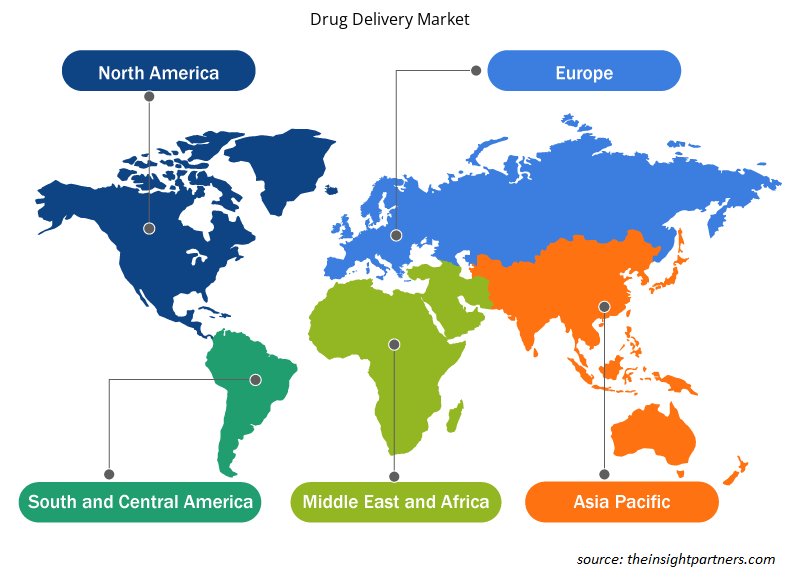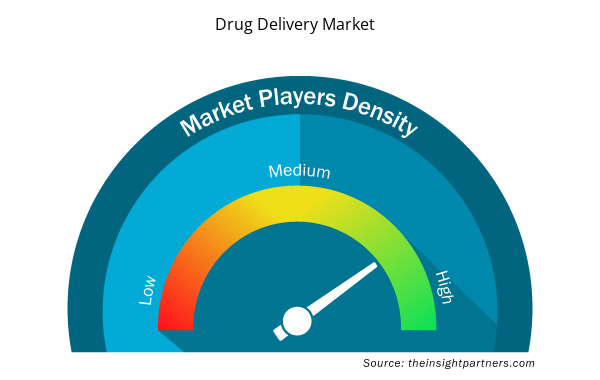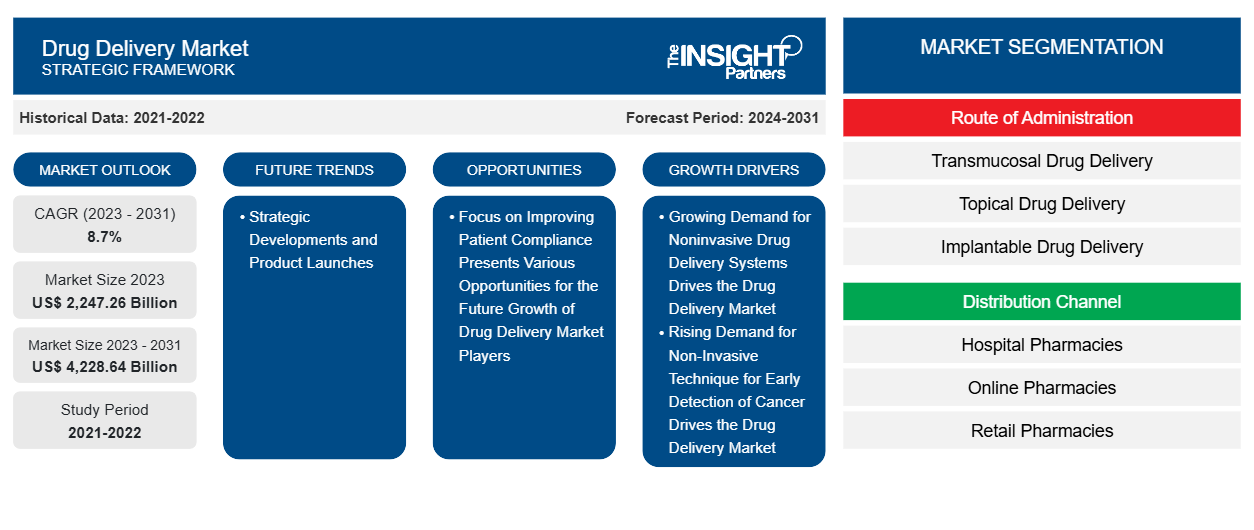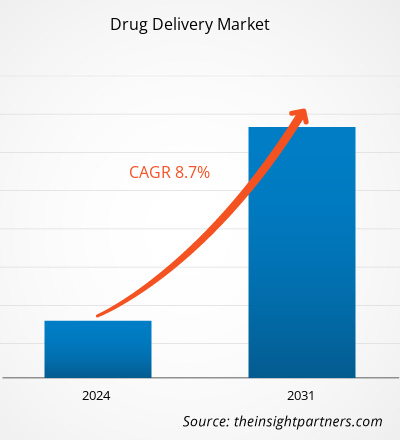药物输送市场规模预计将从 2023 年的 22,472.6 亿美元增至 2031 年的 42,286.4 亿美元。预计 2023-2031 年期间市场复合年增长率将达到 8.7%。战略发展和产品发布可能仍是市场的主要趋势。
药物输送市场分析
慢性病往往会随着时间的推移而恶化,给患者、患者家属和社会带来沉重的负担。根据国际糖尿病联盟 (IDF) 的数据,2017 年约有 4.25 亿人患有糖尿病,预计到 2045 年这一数字将达到 6.29 亿。糖尿病是一种危及生命的慢性疾病,目前尚无专门的治疗方法。糖尿病可导致身体不同部位出现多种并发症,增加过早死亡的风险。与糖尿病相关的主要并发症包括肾衰竭、心脏病发作、中风、截肢、视力丧失和神经损伤。全球糖尿病病例数一直在大幅增加。
近几十年来,慢性病的发病率不断上升,导致药物输送系统的研究和开发 (R&D) 不断加强。使用药物输送系统有助于减少药物的全身副作用。已经开发出各种药物输送载体,用于针对各种慢性疾病(包括心肌缺血、哮喘、肺结核、帕金森病、糖尿病、癌症、动脉粥样硬化和阿尔茨海默病)进行靶向和控制治疗。合适的药物输送系统可以确保药物在较长时间内具有较高的生物利用度,从而增强药物的治疗效果。靶向药物输送系统 (TDDS) 以受控方式在体内特定部位释放药物。基于纳米技术的输送系统对癌症治疗产生了重大影响。除了给药途径类型外,纳米治疗药物输送系统 (NDDS) 还具有多种技术优势,包括增加药物循环时间、控制和持续释放药物、延长半衰期、改善生物分布和提高细胞间药物浓度。
慢性病患者依赖于持续的药物治疗,而药物治疗又伴随着持续的副作用风险。为特定药物创建有效的给药系统有助于将药物集中在患处,最大程度地减少总体副作用并改善患者的治疗效果。因此,慢性病和生活方式疾病的日益流行支持了药物给药市场的扩张。
定制此报告以满足您的需求
您可以免费定制任何报告,包括本报告的部分内容、国家级分析、Excel 数据包,以及为初创企业和大学提供优惠和折扣
- 获取此报告的关键市场趋势。这个免费样品将包括数据分析,从市场趋势到估计和预测。
药物输送市场概况
推动药物输送市场增长的主要因素包括对非侵入性药物输送系统的需求不断增长、制药公司研发支出不断增加以及慢性病发病率不断上升,这些因素推动了市场的增长。然而,药物和输送系统的高成本以及药物输送系统中的产品召回阻碍了市场的增长。
药物输送市场驱动因素和机遇
药企加大研发投入 利好市场
研发是任何公司业务的重要组成部分。根据 Matej Mikulic 的一项研究“2014-2028 年全球制药研发总支出”,2021 年全球制药行业的研发支出约为 2380 亿美元。与其他行业相比,制药公司更受创造创新产品的需求驱动,并在研发上投入大量资金。这主要是由于药品的专利保护时间有限,以及仿制药和生物仿制药的竞争导致销售额下降的威胁。制药和医疗器械公司专注于研发,以推出具有最大医疗和商业潜力的各种治疗应用的新分子。强大的研发能力也有助于他们将高质量和创新的产品推向市场。多年来,生物制药公司的研发支出也在增加。
根据 IQVIA 的一项研究“2022 年全球研发趋势”,2021 年全球共推出 84 种新型活性物质 (NAS),过去 20 年推出的总数达到 883 种。美国仍然是最早推出和数量最多的国家。2021 年全球推出的 72 种 NAS 中有 44 种(超过 60%)被 FDA 批准为同类首创药物,40 种(超过 50%)被指定为孤儿药,表明它们可用于治疗罕见疾病。由于人们对生命科学的兴趣很高,美国的风险投资交易和投资流量在过去两年中有所增加。 2021 年,该国记录了 2,000 多笔交易,交易价值达 470 亿美元。此外,15 家最大的制药公司在 2021 年的研发支出为 1,330 亿美元,比 2016 年增长了 44%。
战略发展和产品发布
在药物输送市场运营的公司不断关注战略发展,如合作、伙伴关系、协议和新产品发布,这有助于他们提高销售额。新产品的发布主要是为了提高安全性、用户友好功能、更好的剂量能力等,以吸引大量患者。通过改进的剂量能力,药物输送系统可以补充治疗结果并增加家庭护理环境中疾病管理的潜力。下面提到了药物输送市场的一些值得注意的发展。
• 2022 年 6 月,Esteve Pharmaceuticals GmbH 在德国推出了 INBRIJA 33 毫克(硬胶囊中的左旋多巴吸入粉剂)。INBRIJA 在欧盟适用于间歇性治疗患有帕金森病的成年人的发作性运动波动,与左旋多巴/多巴脱羧酶抑制剂一起服用。
• 2022 年 6 月,EVERSANA 与 Accord BioPharma 合作支持推出 CAMCEVI(亮丙瑞林)42 毫克注射乳剂,用于治疗成人晚期前列腺癌。
• 2023 年 3 月,Stevanato Group 与 Recipharm 合作开发和制造预灌装注射器,该注射器将集成到新的软雾吸入器中,用于吸入敏感生物制品。新的战略合作旨在为使用 Recipharm 专有软雾吸入器的制药和生物制药公司提供创新的初级包装。
预计未来几年此类战略发展和产品发布的不断增多将为药物输送市场带来新的增长趋势。
药物输送市场报告细分分析
有助于得出药物输送市场分析的关键部分是给药途径、分销渠道和最终用户。
- 根据给药途径,药物输送市场分为透粘膜给药、局部给药、植入式给药、注射式给药、口服给药和眼部给药。注射式给药部分进一步分为传统注射装置和先进装置。口服给药部分进一步细分为固体口服药物、液体口服药物和半固体口服药物。局部给药部分进一步细分为半固体局部给药、液体局部给药制剂、固体局部给药制剂和透皮给药。透粘膜给药进一步细分为肺部和鼻腔给药、口腔和舌下给药、直肠透粘膜给药和阴道透粘膜给药。眼部给药进一步细分为眼药水和喷雾剂、凝胶和软膏、眼部插入物和泪点塞以及治疗性隐形眼镜。注射式给药部分在 2023 年占据了最大的市场份额。
- 根据分销渠道,市场分为零售药店、医院药店和在线药店。2023 年,医院药店占据了最大的市场份额。
- 就终端用户而言,市场细分为家庭护理环境、医院和诊所以及其他终端用户。2023 年,医院和诊所部分占据了相当大的市场份额。
按地区划分的药物输送市场份额分析
药物输送市场报告的地理范围主要分为五个区域:北美、中东和非洲、亚太地区、欧洲、南美和中美。
北美占据了市场主导地位。据美国疾病控制与预防中心 (CDC) 报告,2022 年,美国有近 3730 万人患有糖尿病。1 型糖尿病约占总数的 3.75%,约 145 万人。因此,预计该国糖尿病患者人数的增加将推动对治疗糖尿病患者不同药物输送系统的需求。
药物输送市场区域洞察
Insight Partners 的分析师已详细解释了预测期内影响药物输送市场的区域趋势和因素。本节还讨论了北美、欧洲、亚太地区、中东和非洲以及南美和中美洲的药物输送市场细分和地理位置。

- 获取药物输送市场的区域特定数据
药物输送市场报告范围
| 报告属性 | 细节 |
|---|---|
| 2023 年的市场规模 | 22472.6亿美元 |
| 2031 年市场规模 | 42286.4亿美元 |
| 全球复合年增长率(2023 - 2031) | 8.7% |
| 史料 | 2021-2022 |
| 预测期 | 2024-2031 |
| 涵盖的领域 | 按给药途径
|
| 覆盖地区和国家 | 北美
|
| 市场领导者和主要公司简介 |
|
药物输送市场参与者密度:了解其对业务动态的影响
药物输送市场正在快速增长,这得益于终端用户需求的不断增长,而这些需求又源于消费者偏好的不断变化、技术进步以及对产品优势的认识不断提高等因素。随着需求的增加,企业正在扩大其产品范围,进行创新以满足消费者的需求,并利用新兴趋势,从而进一步推动市场增长。
市场参与者密度是指在特定市场或行业内运营的企业或公司的分布情况。它表明在给定市场空间中,相对于其规模或总市场价值,有多少竞争对手(市场参与者)存在。
在药物输送市场运营的主要公司有:
- 辉瑞公司,
- 强生公司,
- 碧迪公司,
- 诺和诺德公司
- 波士顿科学公司
- 百特国际公司
免责声明:上面列出的公司没有按照任何特定顺序排列。

- 了解药物输送市场顶级关键参与者概况
药物输送市场新闻和最新发展
通过收集一手和二手研究后的定性和定量数据来评估药物输送市场,其中包括重要的公司出版物、协会数据和数据库。以下列出了药物输送市场的一些发展情况:
- 强生公司宣布,麻省理工学院 (MIT) 的罗伯特·兰格博士 (Robert Langer) 获得 2023 年保罗·詹森博士生物医学研究奖。兰格博士因其在设计新型药物输送系统方面的开创性工作而获得此殊荣,该系统可以长时间连续、精确地以可控的速率输送药物。他对用于药物输送的生物医学化合物的开创性研究对广泛的医疗技术产生了影响,包括抗癌治疗、疫苗开发、基因治疗等。(来源:强生公司,通讯,2024 年 2 月)
- Aptar Pharma 是 AptarGroup, Inc. (NYSE: ATR) 旗下子公司,该公司是药物输送系统、服务和活性材料科学解决方案领域的全球领导者。该公司今天宣布推出 APF Futurity,这是其首款无金属多剂量鼻腔喷雾泵,用于输送鼻腔盐水和其他类似的非处方 (OTC) 制剂。(来源:Aptar Pharma,新闻稿,2024 年 1 月)
药物输送市场报告覆盖范围和交付成果
“药物输送市场规模和预测(2021-2031)”报告对以下领域进行了详细的市场分析:
- 药物输送市场规模及全球、区域和国家层面所有主要细分市场的预测
- 药物输送市场趋势以及市场动态,如驱动因素、限制因素和关键机遇
- 详细的 PEST/波特五力分析和 SWOT 分析
- 药物输送市场分析涵盖主要市场趋势、全球和区域框架、主要参与者、法规和最新市场发展
- 行业格局和竞争分析,涵盖市场集中度、热点图分析、知名参与者以及药物输送市场的最新发展
- 详细的公司简介
- 历史分析(2 年)、基准年、预测(7 年)及复合年增长率
- PEST 和 SWOT 分析
- 市场规模价值/数量 - 全球、区域、国家
- 行业和竞争格局
- Excel 数据集


- Nuclear Waste Management System Market
- Diaper Packaging Machine Market
- Equipment Rental Software Market
- Workwear Market
- Single-Use Negative Pressure Wound Therapy Devices Market
- Electronic Data Interchange Market
- Thermal Energy Storage Market
- Clinical Trial Supplies Market
- Online Exam Proctoring Market
- GNSS Chip Market

Report Coverage
Revenue forecast, Company Analysis, Industry landscape, Growth factors, and Trends

Segment Covered
This text is related
to segments covered.

Regional Scope
North America, Europe, Asia Pacific, Middle East & Africa, South & Central America

Country Scope
This text is related
to country scope.
常见问题
The North America region held the largest share of in the drug delivery market 2023.
Factors such as rising incidence of chronic diseases, growing demand for non-invasive drug delivery systems, and increasing R&D expenditures in pharmaceutical companies propel the drug delivery market.
Strategic developments and product launches will be the trend in the drug delivery market.
The drug delivery market majorly consists of the players, including Pfizer Inc, Johnson & Johnson, Becton Dickinson and Co, Novo Nordisk AS, Boston Scientific Corp, Baxter International Inc, Gerresheimer AG, Kindeva drug delivery LP, GlaxoSmithKline Plc, Bausch Health Companies, Novartis AG, Sever Pharma Solutions, and Boehringer Ingelheim International.
The drug delivery market is expected to be valued at US$ 4,228.64 billion in 2031.
The drug delivery market is estimated to record a CAGR of 8.7% till 2031.
Trends and growth analysis reports related to Life Sciences : READ MORE..
The Insight Partners performs research in 4 major stages: Data Collection & Secondary Research, Primary Research, Data Analysis and Data Triangulation & Final Review.
- Data Collection and Secondary Research:
As a market research and consulting firm operating from a decade, we have published and advised several client across the globe. First step for any study will start with an assessment of currently available data and insights from existing reports. Further, historical and current market information is collected from Investor Presentations, Annual Reports, SEC Filings, etc., and other information related to company’s performance and market positioning are gathered from Paid Databases (Factiva, Hoovers, and Reuters) and various other publications available in public domain.
Several associations trade associates, technical forums, institutes, societies and organization are accessed to gain technical as well as market related insights through their publications such as research papers, blogs and press releases related to the studies are referred to get cues about the market. Further, white papers, journals, magazines, and other news articles published in last 3 years are scrutinized and analyzed to understand the current market trends.
- Primary Research:
The primarily interview analysis comprise of data obtained from industry participants interview and answers to survey questions gathered by in-house primary team.
For primary research, interviews are conducted with industry experts/CEOs/Marketing Managers/VPs/Subject Matter Experts from both demand and supply side to get a 360-degree view of the market. The primary team conducts several interviews based on the complexity of the markets to understand the various market trends and dynamics which makes research more credible and precise.
A typical research interview fulfils the following functions:
- Provides first-hand information on the market size, market trends, growth trends, competitive landscape, and outlook
- Validates and strengthens in-house secondary research findings
- Develops the analysis team’s expertise and market understanding
Primary research involves email interactions and telephone interviews for each market, category, segment, and sub-segment across geographies. The participants who typically take part in such a process include, but are not limited to:
- Industry participants: VPs, business development managers, market intelligence managers and national sales managers
- Outside experts: Valuation experts, research analysts and key opinion leaders specializing in the electronics and semiconductor industry.
Below is the breakup of our primary respondents by company, designation, and region:

Once we receive the confirmation from primary research sources or primary respondents, we finalize the base year market estimation and forecast the data as per the macroeconomic and microeconomic factors assessed during data collection.
- Data Analysis:
Once data is validated through both secondary as well as primary respondents, we finalize the market estimations by hypothesis formulation and factor analysis at regional and country level.
- Macro-Economic Factor Analysis:
We analyse macroeconomic indicators such the gross domestic product (GDP), increase in the demand for goods and services across industries, technological advancement, regional economic growth, governmental policies, the influence of COVID-19, PEST analysis, and other aspects. This analysis aids in setting benchmarks for various nations/regions and approximating market splits. Additionally, the general trend of the aforementioned components aid in determining the market's development possibilities.
- Country Level Data:
Various factors that are especially aligned to the country are taken into account to determine the market size for a certain area and country, including the presence of vendors, such as headquarters and offices, the country's GDP, demand patterns, and industry growth. To comprehend the market dynamics for the nation, a number of growth variables, inhibitors, application areas, and current market trends are researched. The aforementioned elements aid in determining the country's overall market's growth potential.
- Company Profile:
The “Table of Contents” is formulated by listing and analyzing more than 25 - 30 companies operating in the market ecosystem across geographies. However, we profile only 10 companies as a standard practice in our syndicate reports. These 10 companies comprise leading, emerging, and regional players. Nonetheless, our analysis is not restricted to the 10 listed companies, we also analyze other companies present in the market to develop a holistic view and understand the prevailing trends. The “Company Profiles” section in the report covers key facts, business description, products & services, financial information, SWOT analysis, and key developments. The financial information presented is extracted from the annual reports and official documents of the publicly listed companies. Upon collecting the information for the sections of respective companies, we verify them via various primary sources and then compile the data in respective company profiles. The company level information helps us in deriving the base number as well as in forecasting the market size.
- Developing Base Number:
Aggregation of sales statistics (2020-2022) and macro-economic factor, and other secondary and primary research insights are utilized to arrive at base number and related market shares for 2022. The data gaps are identified in this step and relevant market data is analyzed, collected from paid primary interviews or databases. On finalizing the base year market size, forecasts are developed on the basis of macro-economic, industry and market growth factors and company level analysis.
- Data Triangulation and Final Review:
The market findings and base year market size calculations are validated from supply as well as demand side. Demand side validations are based on macro-economic factor analysis and benchmarks for respective regions and countries. In case of supply side validations, revenues of major companies are estimated (in case not available) based on industry benchmark, approximate number of employees, product portfolio, and primary interviews revenues are gathered. Further revenue from target product/service segment is assessed to avoid overshooting of market statistics. In case of heavy deviations between supply and demand side values, all thes steps are repeated to achieve synchronization.
We follow an iterative model, wherein we share our research findings with Subject Matter Experts (SME’s) and Key Opinion Leaders (KOLs) until consensus view of the market is not formulated – this model negates any drastic deviation in the opinions of experts. Only validated and universally acceptable research findings are quoted in our reports.
We have important check points that we use to validate our research findings – which we call – data triangulation, where we validate the information, we generate from secondary sources with primary interviews and then we re-validate with our internal data bases and Subject matter experts. This comprehensive model enables us to deliver high quality, reliable data in shortest possible time.


 获取此报告的免费样本
获取此报告的免费样本